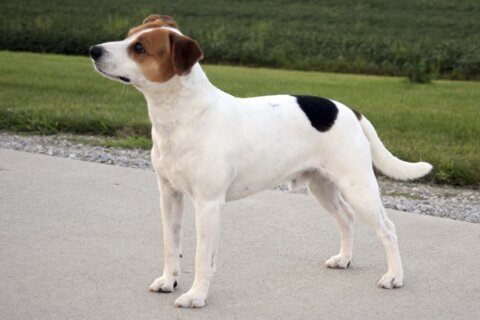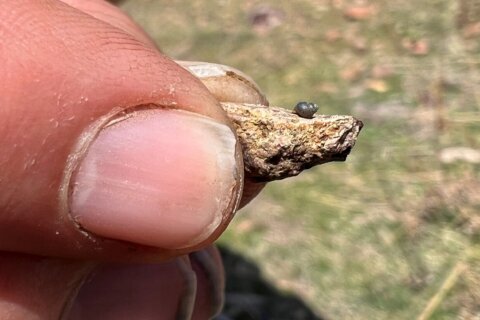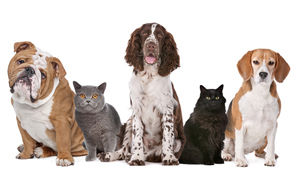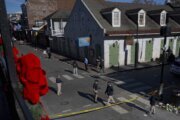FLAGSTAFF, Ariz. (AP) — Kicking up a cloud of dust, the men riding bareback were in a rowdy scramble to be the first to lean down from atop their horses and grab hold of the chicken that was buried up to its neck in the ground.
The competition is rarely on display these days and most definitely not with a live chicken. And yet, it was this Navajo tradition and other horse-based contests in tribal communities that evolved into a modern-day sport that now fills arenas far and wide: rodeo.
With each competition, Native Americans have made them decidedly theirs — a shift from the Wild West shows and Fourth of July celebrations of centuries past that reinforced stereotypes. Rodeo has provided a stage for Native Americans, many of whom had nomadic lifestyles before the U.S. established reservations, to hone their skills and deepen their relationship with horses.
“It was really a way to bring something good out of a really tough situation and become successful economically and, of course, have some joy and celebration in the rodeo world,” said Jessica White Plume, who is Oglala Lakota and oversees a horse culture program for the Mandan, Hidatsa and Arikara Nation in North Dakota.
The sport was born in the mastering of skills that came as horses transformed hunting, travel and welfare. Grandstands often play host to mini family reunions while Native cowboys and cowgirls show off their skills roping, riding and wrestling livestock.
One of those rising stars is Najiah Knight, a 17-year-old who is Paiute from the Klamath Tribes and trying to become the first female bull rider to compete on the Professional Bull Riders tour. Her upbringing in a small town riding livestock is a familiar tale across Indian Country.
Growing up, Ed Holyan’s grandma would drop off him and his brother in Coyote Canyon — an isolated and rugged spot on the Navajo Nation — to tend sheep. When they got bored, they’d rope rocks, the Shetland pony and calves with small horns, he said.
“We’d seen my dad rodeo and my older brother rodeoed, so we knew we had the foundation,” said Holyan, the rodeo coach at Diné College in Tsaile, Arizona. “It was in our blood.”
For Kennard Real Bird, who rode saddle broncs for 16 years, horses provided freedom on the Crow reservation in Montana. The river where the Battle of Little Bighorn took place coursed through the land, prairie extended into pine trees and high buttes beckoned with even wider-ranging views.
The ranching life developed into a career as a stock contractor and a reluctant rodeo announcer who deals in observational comedy, including at the Sheridan, Wyoming, rodeo.
No event there is as big of a crowd pleaser than the Indian Relay Races held in July — a contest rooted in buffalo hunts on the Great Plains or raids of camps, depending on who you ask.
A team consists of someone to catch the incoming horse, two people to hold horses and a rider who speeds around the track bareback, twice switching to another horse.
“It’s the most fun you can have with your moccasins on,” Real Bird, 73, jokingly tells crowds.
Kidding aside, horsemanship is a celebrated part of tribes’ history.
On the Crow and Fort Berthold reservations, tribal members compete for the title of ultimate warrior by running, canoeing and bareback horse racing. Back on the Navajo Nation in the Four Corners region, rodeo is still called “ahoohai,” derived from the Navajo word for “chicken.”
The Nueta Hidatsa Sahnish College on the Fort Berthold reservation offers Great Plains horsemanship as a tract in its two-year equine studies program, the only such program at a tribal college or university.
Instructors highlight history like keeping prized horses in an earth lodge and the North Dakota Six Pack, a group of bronc and bull riders that included MHA Nation citizen Joe Chase, who shined on the rodeo circuit in the 1950s, said Lori Nelson, the college’s director of Agriculture and Land Grants.
The tribe recently purchased kid-safe mini bulls and has bucking horses to revive rodeo among the youth, said Jim Baker, who manages the tribe’s Healing Horse Ranch.
“That’s one of our goals to keep the horse culture alive among our people,” he said.
The largest stage for all-Native rodeo competitors is the Indian National Finals Rodeo held in Las Vegas. Tribal regalia, blessings bestowed by elders and flag songs that serve as tribes’ national anthems are as much staples as big buckles and cowboy hats.
Tydon Tsosie, of Crownpoint, New Mexico, restored the town’s moniker to “Navajo Nation Steer Wrestling Capital” when he won the open event there this year as a 17-year-old. In his family, rodeo runs through generations with songs, prayers and respect for horses.
Tsosie plans to continue the tradition, proudly proclaiming, “I see myself doing it for the rest of my life until I get old.”
___
This story is part of the AP’s Inclusive Journalism Initiative with The Maynard Institute for Journalism Education and The Ida B. Wells Society for Investigative Reporting.
___
More AP sports: https://apnews.com/hub/sports and https://twitter.com/AP_Sports
Copyright © 2025 The Associated Press. All rights reserved. This material may not be published, broadcast, written or redistributed.







